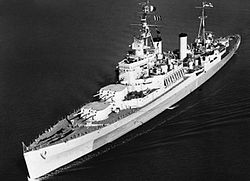Royal Canadian Navy
The Royal Canadian Navy (RCN) was the navy of Canada from 1911 to 1968.
His Majesty having been graciously pleased to authorize that the Canadian Naval Forces shall be designated the "Royal Canadian Navy," this title is to be officially adopted, the abbreviation thereof being 'RCN'.
From 4 May 1910 to 29 August 1911, the navy was known officially as the Naval Service of Canada and operationally as Canadian Naval Forces.[1]
During the early years of the 20th century, there was a lot of talk in the British Empire as to the role the Dominions would play in defence and foreign affairs. Because of the developing naval arms race with Germany, a key part of this discussion focused on naval issues.
In Canada, the naval debate came down to a choice between two options: either the young country could provide funds, support and manpower to the Royal Navy, or it could form its own navy, which could help support the Royal Navy if necessary. After extensive political debates, Canadian politicians chose to set up their own navy.[2]
The Royal Canadian Navy Served with the Royal Navy in World Wars I and II, but during the Suez Crisis of the 1950s Canada and the United Kingdom had different political views. Coupled with mutinies in 1949, partly linked to old British ways the Canadian government started looking at making sure the Canadian Navy had a very separate identity from the Royal Navy. In August of 2011 the three services were once again separated, ending decades of confusion and low morale. The Royal Canadian Navy, the Canadian Army and Royal Canadian Air Force were reinstated.
HMCS Québec, formerly HMS Uganda, was one of many ships commissioned by the RCN in the Second World War. Expanding substantially during the war, the RCN had become the world's third-largest navy (471 warships and auxiliary vessels) by 1945.
Four F2H-3 Banshees fly overhead HMCS Bonaventure. Bonaventure was the last aircraft carrier in service with the RCN.
HMCS Athabaskan departing Halifax for the Persian Gulf as part of the Coalition forces. Canada deployed three ships in support of Operation Desert Shield, and later Operation Desert Storm
CFB Halifax is the headquarters for RCN units from Maritime Forces Atlantic.
CFB Esquimalt is the headquarters for RCN units from Maritime Forces Pacific.
HMCS St. John's, one of 12 Halifax-class multi-role frigates in service with RCN
References
- ↑ J. A. Foster Heart of Oak, Pictorial History Royal Canadian Navy Methuen 1985
- ↑ Marc Milner, "It Began With Fish And Ships: Navy, Part 1 Archived 2012-03-25 at the Wayback Machine", Legion Magazine, 01 January 2004. Accessed 02 May 2010.







